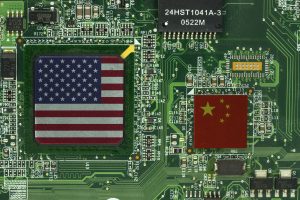The Diplomat author Mercy Kuo regularly engages subject-matter experts, policy practitioners, and strategic thinkers across the globe for their diverse insights into U.S. Asia policy. This conversation with Dr. Richard Silberglitt – senior physical scientist and professor at Pardee RAND Graduate School, RAND Corporation– is the 326th in “The Trans-Pacific View Insight Series.”
Identify the three topline takeaways of your co-authored report, “Use of Predictive Analytic Tools to Assess Technological Emergences and Acquisition Targets.”
From 1990-2017, the United States was the leader — the first country in which the emergence occurred — for far more technological emergences than any other country in six general technical areas of interest to the Department of the Air Force: Additive Manufacturing (AM), Artificial Intelligence (AI), Ceramics, Quantum, and Sensors.
When China’s emergence occurs after that of the United States, i.e., China is the follower, the time lag between the initiation of the emergence in the two countries is much larger than for the much smaller number of emergences for which China is first and the United States follows.
Technological emergences in China rise significantly more rapidly than those in the United States, and in the most recent time period studied (2009-2017) there are more early patent filings (i.e., within the first two years after emergence) in China than in the United States for emergences in the six general technical areas studied that occur within three years of each other in the two countries.
Explain the report’s methodology and role of U.S. and Chinese patent filings and applications in measuring technological emergences and acquisition targets.
We identified technological emergences by detecting rapid increases in the cumulative number of patent applications filed in specific technical areas, using a large dataset that includes all international patent filings and issued patents since 2001. We designated the country in which an emergence occurs first as the “technological leader” in that specific technical area, because it is most likely the home of the inventors, and its patent filers are often the leaders in the most important applications of that technology. When an emergence occurs in the same specific technical area, which we define according to the Cooperative Patent Classification (CPC) Scheme, at a later time in another country, we designated that country as a “follower.”
We compared the years of emergence between the U.S. and China for all emergences between 2001 and 2017 in the six general technical areas studied to determine who was the leader and who was the follower. The organizations that have the earliest patent applications in an emergence in the country that is the “technological leader” may be attractive acquisition targets, especially if their patent applications are early in more than one emergence, suggesting the possible application of an emerging technology in one or more different emerging technology areas.
Compare and contrast U.S. and Chinese technological leadership and comparative advantage.
The U.S. is the “technological leader” many more times than any other country in the six general technical areas studied over the entire time period studied (1990-2017). When the U.S. and China both have emergences in the same specific technical area, the U.S. is the “technological leader” many more times than China. For the smaller number of times when China is the “technological leader,” and the U.S. is the “follower,” the time between leader and follower emergences is much shorter than when China is the “follower,” which suggests that, over the time period and in the general technical areas studied, the U.S. has been in a stronger position when a technological “follower” than China has been when a technological “follower.”
Examine international patent trends and the trajectory for U.S.-China tech competition.
We made a detailed comparison of the patent filings of the U.S. and China in the small number of specific technical areas with emergences (2 percent of total emergences) in which the emergences in the U.S. and China occur within 1-3 years of each other, which we call “close emergences.” For these close emergences, we found a time-dependent difference when comparing the number of early patent filings in the U.S. and China:
- From 2001-2008, most of the early patent filings in close emergences in the general technical areas studied were in the U.S.
- From 2009-2017, the number of close emergences in which China has the majority of early patent filings is greater than the number of close emergences in which the U.S. has the majority of early patent filings in all six general technical areas studied.
Assess the policy implications of the report’s findings and recommendations for U.S. policymakers and industry leaders.
While the U.S. continues to be the “technological leader” in the general technology areas studied, China is filing more early patent applications in recent years than the U.S. in specific technical areas for which the U.S. and China have emergences within 1-3 years of each other (“close emergences”). To properly evaluate technological leadership in these specific technical areas, U.S. policymakers and industry leaders should perform a detailed comparative analysis of the quality of the patent filings and products on the world market of the early filers in the U.S. and China.
To identify the specific technology areas in which the U.S. is the “technological leader” and there are U.S. companies with technologically leading capabilities that could make them attractive for possible foreign acquisition, U.S. policymakers and industry leaders should examine organizations with early patent applications that are early in more than one emergence, suggesting the possible application of an emerging technology in one or more different emerging technology areas.

































